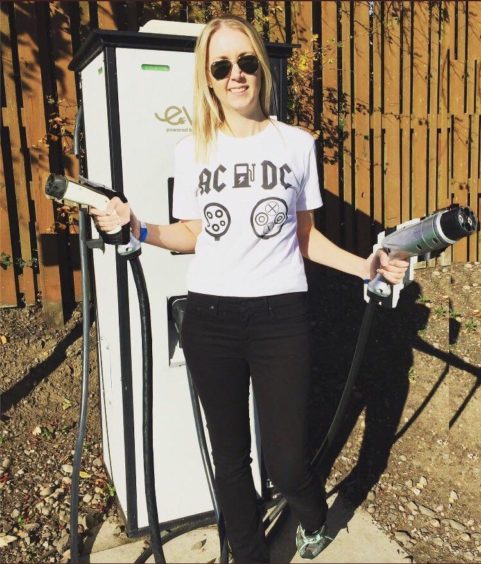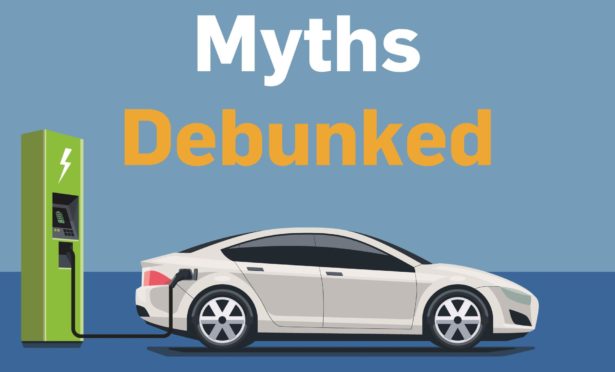DID you know that by 2035, there will be no new petrol and diesel vehicles for sale? That’s the country’s long-term plan, so chances are we will all own an electric car in the future.
When the first EVs were released a few years ago, there were many barriers that would deter drivers from buying – including cost, charging and mileage, to name a few. But in the year 2021 it is a much more viable option to petrol and diesel vehicles. And if the infrastructure is anything to go by, Dundee is one of the easiest cities in which to drive and own an electric car.
Here we explore the main reasons people may have been put off purchasing an electric car as we debunk the myths and show you how an EV is an affordable and tempting alternative to petrol and diesel motors.

“I can’t drive an electric car because they don’t have enough mileage” – YES, THEY DO
Electric vehicles have come a long way over the years; the newest generation of EVs offer various different mileages, with top-of-therange models going up to 300 miles and above. More affordable options can even offer 250 miles plus – and charging is now faster than ever, with a number of models offering up to 100kw plus charging capability. You’ll be able to travel pretty far on a single charge – and for longer journeys, you can use chargeplacescotland.org or zap-map.com to find suitable charging stops. Plus, the future is only looking brighter, with features like wireless charging and even faster charging times all being tried-and-tested. As other places catch up with Dundee when it comes to EV infrastructure, travelling across the country will only become easier.
“I don’t know where I would charge it” – YES, YOU DO
There is funding available (see the Energy Saving Trust website) for installing a domestic charge point, but don’t worry if that isn’t an option.
Dundee is leading the way in Europe when it comes to EV infrastructure, so you’ll find a choice of charging options to suit while you’re on the go in the city. As well as on-street electric charging bays and pop-up electric chargers, Dundee boasts state-of-the-art charging points on Princes Street (previously a petrol station but now one of the most advanced EV charging hubs in the country, capable of charging 18 EVs at the same time), Queen Street and Lochee. There’s also a new charging hub at Green Market, with more to follow at Olympia and Bell Street multi-storey car parks.
TOP TIP: Make sure to register for a Charge Place Scotland card which will activate most chargers across the country.
 “I can’t buy an EV as I don’t have anywhere to park” – YES, YOU DO
“I can’t buy an EV as I don’t have anywhere to park” – YES, YOU DO
Dundee City Council is there to support all residents joining them in the drive to become an ‘electric city’ by switching to an EV – in fact, you’ll even be able to park for free!
All you have to do it register your EV (excluding hybrids) for the scheme and you’ll then be able to park for free in the following council multi-storey car parks:
- Greenmarket
- Gellatly Street
- Olympia
- Bell Street
These car parks use ANPR barrier systems, so once your electric car has been added to the scheme, simply drive up to the barriers and they’ll open for you! While your car is plugged in and charging, you’ll also be able to park for free in on-street charging bays.
 “I cannot afford to buy or run an electric car” – YES, YOU CAN
“I cannot afford to buy or run an electric car” – YES, YOU CAN
Because there is no combustion engine and it is run entirely (or in some cases partially) on electricity, using a rechargeable battery, there is less risk of having a hefty repair bill if things go wrong. So, as there are fewer moving parts in an EV, maintenance costs are less compared to its petrol or diesel equivalent.
Topping it up is very affordable too, at as little as 15p per KW (with a 38p connection fee) in Dundee (and one of its numerous charging points, mentioned above) which is much cheaper than escalating petrol and diesel costs which are creeping up over 120p per litre and 130p per litre.
The biggest outlay, for an EV, is obviously the purchasing. However, the price of EVs have substantially come down in price with the cheapest EV on the market for around £15,000 (Skoda CITIGOe iV in Jan 2020), and you may also be able to pick up a pre-owned one, making it an affordable alternative to petrol/diesel cars.
 “I am disabled/use a wheelchair, so it is difficult to charge an EV” – NO, IT IS NOT
“I am disabled/use a wheelchair, so it is difficult to charge an EV” – NO, IT IS NOT
In fact this very issue was taken in to consideration by Dundee City Council recently and it is looking into introducing chargers with retractable cord reel, making it easier for wheelchair users to charge their cars. Instead of EV chargers having a fixed length of cable, the heavy-duty retractable hose-reel style design allows it to stretch further.
This follows a survey by Zap-Map and Motability which recently found that “many disabled people will be thinking about investing in an electric vehicle but could be put off by a lack of accessibility at public charge point locations”. Manufacturers of chargers are being encouraged to install lighter and more user-friendly cables, making EV chargers accessible to all.
 “I live in a flat/don’t have a driveway, so can’t own an EV” – YES, YOU CAN
“I live in a flat/don’t have a driveway, so can’t own an EV” – YES, YOU CAN
Traditionally electric vehicle charging used to be done at home as it was seen as the most convenient and cost-effective way to recharge its battery. Government grants were also introduced to help residents with driveways or gardens to install a home charge point – however, since then the public electric vehicle charging network has rapidly grown, with Dundee being home to one of the best infrastructures for EV charging.
The public charging points (outlined above) mean that you do not need a driveway/home charger, making it much easier for those in flats to own an EV. You can also park for free as an EV owner.
 “I don’t drive, so I can’t play my part in contributing to the city’s zero emissions target” – YES, YOU CAN
“I don’t drive, so I can’t play my part in contributing to the city’s zero emissions target” – YES, YOU CAN
Switching to an electric car is one way, but for non-drivers, there are many alternate ways to help improve the air quality in Dundee by opting for a more sustainable and environmentally friendly way of travel.
Next time you are boarding a bus, opt to travel on one of Dundee’s modern electric buses or switch to cycling instead. Maybe even consider purchasing an electric bicycle (e-bike) or hire one to help get you around town or on your daily commute.
Case study: Elinor Chalmers

As the director of Electric Vehicle Association Scotland – and having driven an electric car for six years – fewer people know all the benefits of driving an EV in Dundee than Elinor Chalmers (pictured above).
When she bought her electric Nissan Leaf in 2015, she was one of the first EV drivers in her street but there was no better city to own an electric car, as she soon found out.
Elinor Chalmers, the first female director of Electric Vehicle Association Scotland, said: “It is definitely getting easier to own an electric car as Dundee is flying the flag for EV ownership in Scotland in making it as easy as possible for people from all walks of life to drive an EV.”
An EV driver for almost six years, Elinor thought she would struggle to charge her car (as she lived in a flat so didn’t have a driveway), but she didn’t.
Elinor, who is a clinical lecturer at the dental hospital, explained: “I wasn’t able to charge it at home, so the fantastic infrastructure in Dundee made it easier to be able to have my electric car and charge it at a public charger.
“Back then, there were fewer – the infrastructure has quadrupled since then – but it was still possible. “Now most of the time I charge my car when I am at work at the university campus or at the charging hub at the top of Greenmarket car park – there residents can charge overnight and commuters can park for free during the day.
“And I don’t have to worry about having to move my car at lunchtime, or physically sit in my car until it charges up, as I can park there all day – for free – and all I pay for is the electricity I use.”
In her role, Elinor champions the use of EVs and promotes the number of ways that organisations, such as Dundee City Council and SWARCO, are positively contributing towards the city’s zero emissions target and cleaner air, and it’s not all about electric cars.
She explained: “Dundee City Council and SWARCO have such a can-do attitude and – as well as encouraging individuals to drive electric cars – the number of electric taxis is fantastic for the clean air in the city. You also see the council’s, NHS Tayside’s and the university’s fleet vehicles zipping about on the streets of Dundee so this sets a good example and shows that EVs can be an everyday vehicle, not just one for popping to the shops.”
To find out more about electric cars and Dundee’s electric vehicle infrastructure, visit www.drivedundeeelectric.co.uk











